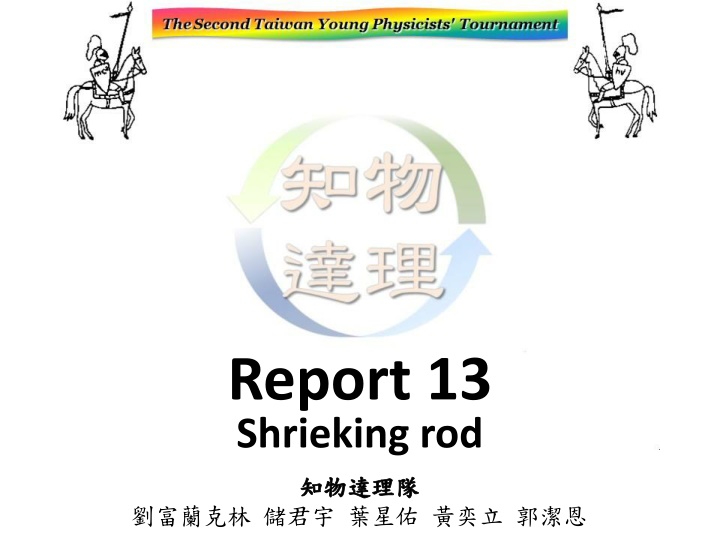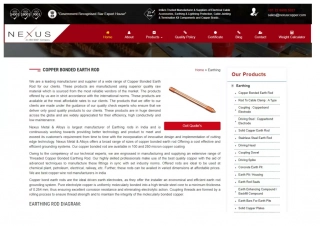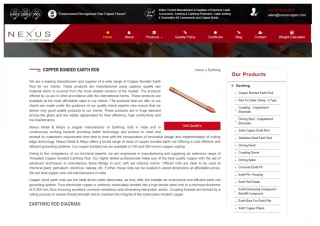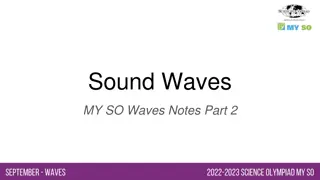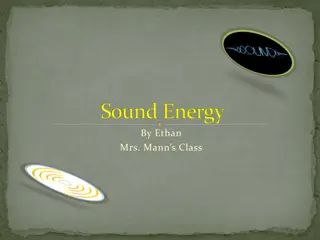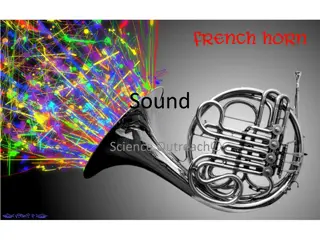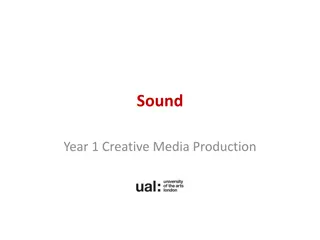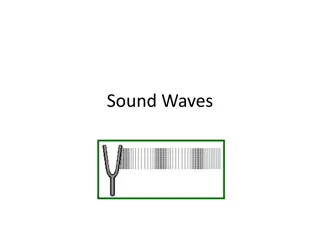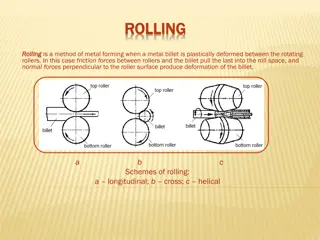Investigating Sound Production in a Metal Rod Experiment
The report explores how the sound produced by hitting a metal rod between two fingers depends on the position of holding and hitting the rod. It delves into the modes of vibration, the effects of transverse motion on air compression, and the quantitative analysis of stress and strain. The experiment setup, results, and conclusions are detailed in the report.
Download Presentation

Please find below an Image/Link to download the presentation.
The content on the website is provided AS IS for your information and personal use only. It may not be sold, licensed, or shared on other websites without obtaining consent from the author.If you encounter any issues during the download, it is possible that the publisher has removed the file from their server.
You are allowed to download the files provided on this website for personal or commercial use, subject to the condition that they are used lawfully. All files are the property of their respective owners.
The content on the website is provided AS IS for your information and personal use only. It may not be sold, licensed, or shared on other websites without obtaining consent from the author.
E N D
Presentation Transcript
Report 13 Shrieking rod
Problem # 13 Shrieking rod A metal rod is held between two fingers and hit. Investigate how the sound produced depends on the position of holding and hitting the rod? Reporter: 2024/9/24 1
Overview Introduction Observation Problem Analysis Experiment Experimental Setup Experiment Results and Discussion Conclusions & Summary References Reporter: 2024/9/24 2
Introduction Observation Two obvious modes of vibration: 1.Transverse motion (Lower frequency) 2. longitudinal motion (higher frequency) video video Reporter: 2024/9/24 3
Introduction Problem Analysis 1. Transverse motion compresses air near rod. -> Amplitude and frequency of sound produced thus depends on elastic modulus of rod. Statics Dynamics Reporter: 2024/9/24 4
Introduction Quantitative Analysis Statics Rod is composed of many parallel fibers Fibers above neutral surface are stretched and fibers below it are compressed. Reporter: 2024/9/24 5
Definition of stress and strain: F Y A = A filament under the neutral surface by distance z, with a cross section is stretched a length: Tensile force of particular filament: d F Y dSdx dS = z l = fil Torque of particular filament: dS Y dx = 2 z fil Reporter: 2024/9/24 6
The bending moment, which is the amount of force it takes to bend the whole segment by an angle of is: 2 z M Y dS dx Also, = = fil 2 = Y 2 y x z 2 y x y x y = = dx 2 x x dx + x dS M = 2 z ds 2 Reporter: 2024/9/24 7
Introduction For a circular cross section, a = 2 y 2 = 2 M Y z ds 2 ( depends only on shape of cross section because is a geometrical quality) x 2 z dS Let: = Then M can be written as: 1 S 2 2 z ds 2 y = 2 M SY 2 x Reporter: 2024/9/24 8
Introduction Dynamics If we consider a shearing force on the end of in a state of equilibrium : dx = F F x M 3 M x y = = 2 F SY 3 x Reporter: 2024/9/24 9
Introduction The differential equation of the motion of the bar: 2 2 4 y y y t x + = 0 2 4 General solution: ( cosh A mx = Predicted frequency: ( 4 8 ) ( ) nt + mx C + + sinh cos sin cos y B mx D mx ) 2 1 n Y ( ) = = 1,2,3... f n 2 Reporter: 2024/9/24 10
Introduction For a stainless steel rod (S347) with a length 1m and diameter 0.6 cm, and plugging in actual data, the first harmonic predicted is: 0.003 9 1 200 10 2 11.9 2 8 7800 0.5 Hz ( ) second harmonic predicted: 0.003 9 2 2 8 0.5 9 200 10 7800 107.4 Hz ( ) Third harmonic predicted: 0.003 25 2 2 8 0.5 9 200 10 7800 298.3 Hz ( ) Reporter: 2024/9/24 11
Introduction For an bronze rod of the same specifications, the predicted first harmonic is: 0.003 9 1 100 10 2 7.9 2 8 8800 0.5 Hz ( ) second harmonic predicted: 0.003 9 100 10 2 2 8 8800 0.5 9 71.5 Hz ( ) Third harmonic predicted: 0.003 25 100 10 2 2 8 0.5 9 198.6 Hz ( ) 8800 Reporter: 2024/9/24 12
Introduction 2. Longitudinal waves: Frequency depends on length of rod allowed to vibrate. The speed of sound in the longitudinal direction. Unfixed ends: antinodes of the standing wave Length of the rod is a multiple of a half of the wavelength: . 2 n = l Reporter: 2024/9/24 13
Introduction Velocity of longitudinal wave , v f = 1 2 l l The shorter the vibrating length, the higher the frequency produced. n = l 2 nv = f Reporter: 2024/9/24 14
Experiment Setup Rods Mallet Oscilloscope and computer Reporter: 2024/9/24 15
Experiment Parameters: Rod material: Stainless steel Bronze Rod diameter: 50cm, 6mm stainless steel rod 50cm ,12mm stainless steel rod Rod length: 40cm stainless steel, bronze rods 50cm stainless steel , bronze rods 90cm stainless steel , bronze rods Position of holding rod: half length quarter length sixth length Method of hitting rod: Hit across rod Hit along rod Reporter: 2024/9/24 16
Introduction Reporter: 2024/9/24 17
Experiment 20 10 100 200 300 400 500 10 20 30 Waveform data of 6mm bronze rod held at half point Reporter: 2024/9/24 18
Experiment 200 150 100 50 100 200 300 400 500 Fourier transform for waveform data, with main peak at 17.0, representing 3400 Hz Reporter: 2024/9/24 19
Hit along rod: longitudinal waves 50cm stainless steel rods 50cm bronze rod 11000 11000 10000 10000 9000 9000 Frequency(Hz) 8000 Frequency(Hz) 8000 7000 7000 stainless theoretical 6000 6000 bronze theoretical 6mm stainless 5000 5000 6mm bronze 12mm stainless 4000 4000 3000 3000 2000 2000 1 2 3 1/2 holding position 1/4 holding position 90cm stainless steel and bronze rod Theory fits well with data in low frequency range The microphone and oscilloscope cannot pick up signals over 10 kHz, and may not be precise in the high frequency range 11000 10000 9000 Frequency(Hz) 8000 7000 stainless theoretical 6000 6mm stainless 5000 bronze theoretical 4000 6mm bronze 3000 2000 1/2 1/4 holding position 1/6 1/8 Reporter: 2024/9/24 20
Hit across rod: Transverse waves Longitudinal waves in 50cm rods 700 600 500 Frequency(Hz) 400 6mm stainless steel 300 12mm stainless steel 6mm bronze 200 100 0 1/2 1/4 1/6 holding position Rod holding position 1/2 1/4 1/6 Stainless Steel, d=6mm 285.7Hz 102.9Hz 303.6Hz Stainless Steel, d=12mm 600.6Hz 219.8Hz 232.9Hz Bronze, d=6mm 197.2Hz 72.15Hz 202Hz 501cm bronze rod: First harmonic: 7.9 Hz (too low) Second harmonic: 71.5 Third harmonic: 198.6 Reporter: 2024/9/24 21
Holding certain points on the rod enforces certain harmonics: Holding half point enforces 1stharmonic, however, the frequency is too low to hear Holding sixth point can enforce 3rd harmonic Holding half point can also enforce 3rd harmonic 700 600 6mm stainless steel 12mm stainless steel 6mm bronze 500 Frequency(Hz) 400 3rd 3rd 2nd 300 200 Holding quarter point can enforce 2nd harmonic 100 0 1/2 1/4 1/6 Reporter: 2024/9/24 22 holding position
Longitudinal waves in 50cm rods 700 3rd 3rd 600 500 6mm stainless steel Frequency(Hz) 400 theoretical 6mm stainless steel 2nd 12mm stainless steel 300 theoretical 12mm stainless steel 6mm bronze 200 theoretical 6mm bronze 100 0 1 2 3 holding position Stainless Steel, d=6mm theoretical Stainless Steel, d=12mm theoretical Bronze, d=6mm theoretical 285.7Hz 298.3Hz 600.6Hz 596.5Hz 197.2Hz 198.6Hz 102.9Hz 107.4Hz 219.8Hz 214.8Hz 72.15Hz 71.5Hz 303.6Hz 298.3Hz 232.9Hz 596.5Hz 202Hz 198.6Hz Reporter: 2024/9/24 23
Results and discussion 12mm rod is too thick to completely control with one hand-> more complications Other data points fall within good range with the theory The theory proves an accurate method to estimate the frequency a thin shrieking rod produces Reporter: 2024/9/24 24
Conclusions & Summary For longitudinal waves, the frequencies each rod produces are multiples of the first harmonic. The theory for longitudinal waves is in accordance with experimental data. For transverse waves, our theory considering the bending moment of the rod accurately predicts the harmonics of thin rods in a wide range, including rods of different material, length and holding position. Reporter: 2024/9/24 25
